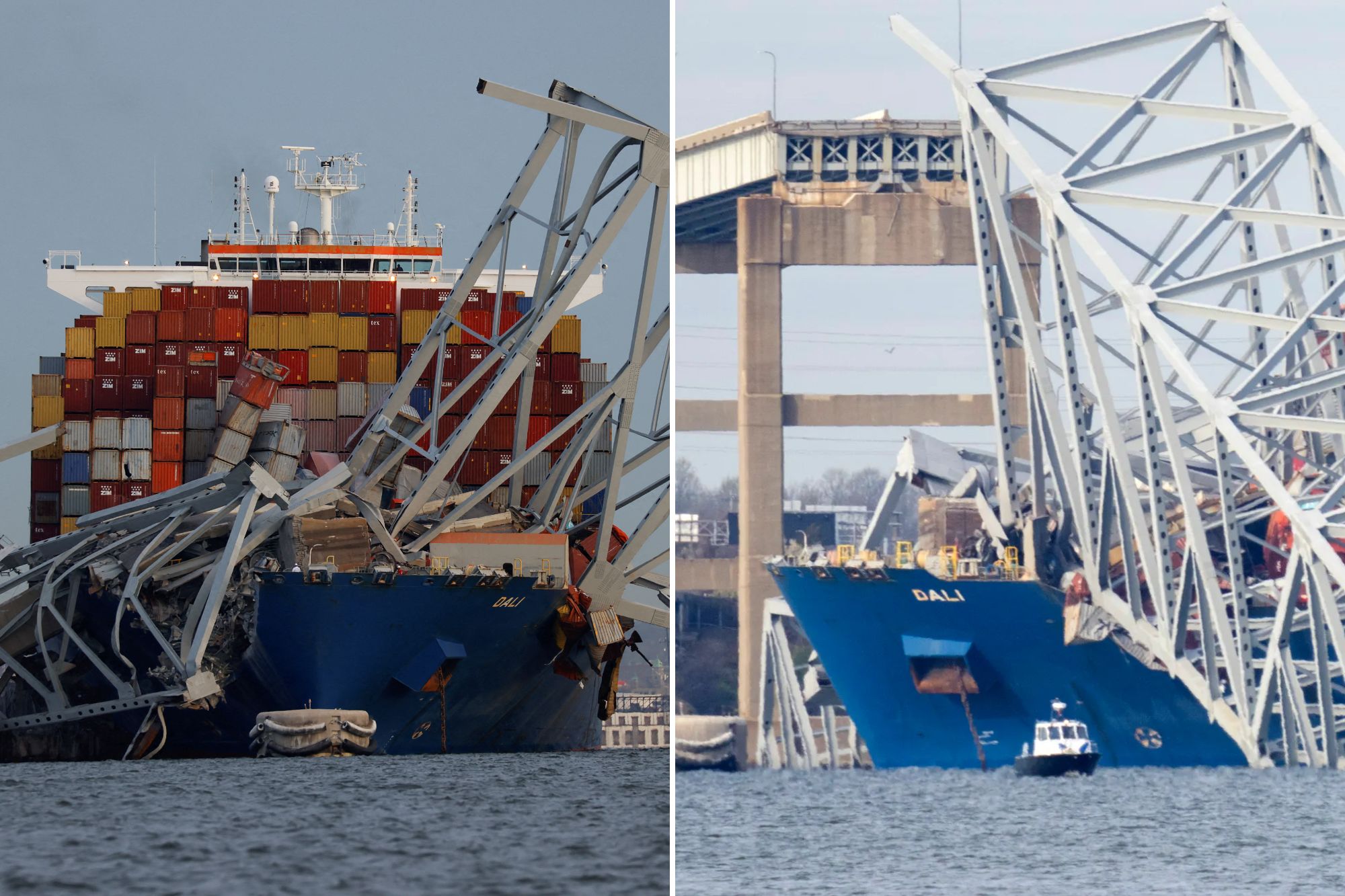
A safety investigation into the Francis Scott Key Bridge collapse in Baltimore, Maryland, will include whether contaminated fuel was a factor in a cargo ship losing power and crashing into the bridge.
Investigators had not boarded the ship, a 948-foot-long container ship called the Dali, as of late Tuesday while it remained stuck on a pillar of the collapsed bridge, and the vessel could stay there for weeks.
Rescue crews spent much of Tuesday searching for potential survivors, but officials announced that the search and rescue had been turned into a recovery operation.
The lights on the Dali began to flicker about an hour into the ship’s trip early Tuesday.
A harbor pilot and assistant reported power issues and a loss of propulsion prior to the collision, according to a Coast Guard briefing report.
“The vessel went dead, no steering power and no electronics,” an officer aboard the ship said Tuesday.
“One of the engines coughed and then stopped. The smell of burned fuel was everywhere in the engine room and it was pitch black.”
The ship did not have enough time to drop anchors to stop drifting, according to the officer, and crew members issued a mayday call before the crash happened.
Blackouts at sea are uncommon, but they do happen and have long been viewed as a major accident risk for ships on the water.
Everything you need to know about the Francis Scott Key Bridge’s collapse in Baltimore
- The Dali, the Singapore-flagged container ship that smashed into the Francis Scott Key Bridge in Baltimore and destroyed it early Tuesday, reportedly lost propulsion and tried to warn officials that it was going to crash, according to a report.
- Six people were unaccounted for, according to authorities. Two people were pulled from the river by rescuers.
- Seven vehicles were missing after falling from the 1.6-mile-long span. Officials are using sonar technology to find the vehicles.
- Videos show power on the ship flickering off, and then on again, shortly before the crash. Watch footage of the bridge’s collapse here.
- A Baltimore resident described how the horrifying collapse of the Francis Scott Key Bridge early Tuesday morning caused his entire house to feel like it was falling down.
- The Dali was also involved in a collision while leaving the Port of Antwerp, Belgium, in 2016.
Follow along with The Post’s coverage of the Francis Scott Key Bridge collapse in Baltimore.
One cause of ship blackouts is contaminated fuel that can create problems with its main power generators, said Fotis Pagoulatos, a naval architect.
He said a complete blackout could result in a ship losing propulsion and that smaller generators can kick in, but they are unable to carry all the functions of the main ones and take time to start.
National Transportation Safety Board chief Jennifer Homendy said during a press conference that the investigation will include reviews of the operations and safety record of the ship and its owner and operator.
Crews will look at securing recorders from the vessel to try and learn what happened leading up to the crash.
“This is a team effort,” Homendy said. “There are a lot of entities right now in the command post.”
The ship, made by South Korea’s Hyundai Heavy Industries, has had more than 20 port state control inspections — reviews of foreign ships in national ports —since it was built in 2015, according to data from Equasis, an international shipping database.
None of the inspections led to a detention, which could happen when a ship is considered unfit to travel. But deficiencies were listed in two of the reviews: one in Belgium in July 2016 that described hull damage and another in Chile in June 2023 that described an issue with the ship’s propulsion and auxiliary machinery.
The US Coast Guard completed a review of the vessel in September 2023 and did not find any issues.
For its trip Tuesday, Singapore-based Synergy Marine Group operated the vessel, which was carrying cargo for Danish shipping giant A.P. Moller-Maersk.
The ship departed from a terminal at the Port of Baltimore and was heading to Sri Lanka. A Singaporean company, Grace Ocean Pte., owns the ship.
Two tugboats helped the ship move out of the terminal Tuesday, but they pulled back early in the trip, according to port officials.
Two pilots and 22 crew members from India were aboard the ship during the crash, according to Darrell Wilson, a spokesman for Synergy Marine.
The ship was moving around 9.2 mph, according to authorities, a typical speed for vessels traveling in the area.
Ships as large as the Dali must maintain a certain speed to avoid being pushed around by winds and currents.
The bridge collapse is expected to result in a multibillion-dollar string of insurance claims, covering the loss of the structure itself, the disruption to businesses using the port and more, according to insurance analysts.
Victims of the crash could also file claims against the ship operator.
The bridge was built in 1977 for more than $60 million, which is around $300 million today when adjusted for inflation.
The Wall Street Journal contributed to this report.














